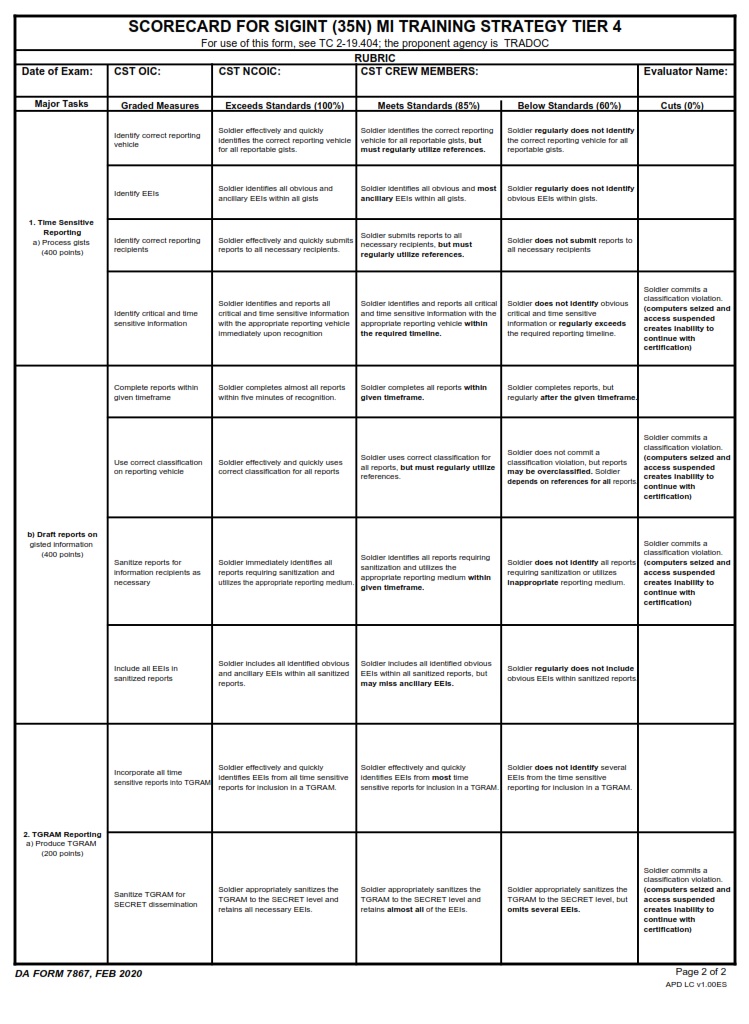Table of Contents
FREE-ONLINE-FORMS.COM – DA Form 7867 – Scorecard For Sigint (35n) Mi Training Strategy Tier 4 – DA Form 7867 – Scorecard for Sigint (35n) MI Training Strategy Tier 4 is an essential tool used by the United States Army to evaluate the competency of its personnel in the military intelligence field. As technology continues to advance, it becomes increasingly important for soldiers to stay up-to-date with the latest techniques and procedures. The DA Form 7867 serves as a means of tracking and assessing the progress of individuals undergoing training in Signals Intelligence (SIGINT) at the Tier 4 level, ensuring that they are fully equipped to carry out their duties effectively.
Download DA Form 7867 – Scorecard For Sigint (35n) Mi Training Strategy Tier 4
| Form Number | DA Form 7867 |
| Form Title | Scorecard For Sigint (35n) Mi Training Strategy Tier 4 |
| Edition Date | 2/1/2020 |
| File Size | 3 MB |
What is a DA Form 7867?
The DA Form 7867 is a document that is used to evaluate the performance of soldiers who have undergone Signals Intelligence (SIGINT) training, particularly those in the 35N Military Occupational Specialty (MOS). This scorecard is part of the Training Strategy Tier 4 and serves as an objective measure of a soldier’s skill proficiency.
The scorecard covers various aspects of SIGINT, including technical skills, analytical abilities, and communication effectiveness. These categories are further subdivided into specific tasks that soldiers must perform during their training. The scores obtained from this assessment will determine whether or not a soldier has met the standards required for their MOS.
Overall, the DA Form 7867 plays an important role in ensuring that soldiers receive adequate training in SIGINT and can carry out their duties effectively. Providing a standardized evaluation process helps to maintain consistency across different units and ensures that all soldiers meet the same high standards.
Where Can I Find a DA Form 7867?
If you are looking for a DA Form 7867, you can find it on the official website of the United States Army. It is readily available for download in PDF format and can be printed out as well. Additionally, you can also find it on various other websites that specialize in government forms.
It is important to note that this form is specifically designed for individuals who are undergoing training related to Signal Intelligence (SIGINT) under the Military Intelligence (MI) field. The form serves as a scorecard and enables trainers to evaluate trainees’ performance during Tier 4 of their MI training strategy.
In conclusion, finding a DA Form 7867 should not be difficult, as it is easily accessible through various online sources. However, keep in mind that this form is only applicable to those undergoing SIGINT training under the MI field’s Tier 4 program. If you have any further questions or concerns about obtaining or using this form, don’t hesitate to contact your trainer or supervisor for assistance.
DA Form 7867 – Scorecard For Sigint (35n) Mi Training Strategy Tier 4
DA Form 7867 is a scorecard used by the U.S. Army to evaluate soldiers in the Signals Intelligence (SIGINT) field. Specifically, it is used for those with the Military Occupational Specialty (MOS) code of 35N, or SIGINT Analysts. This document is part of the MI Training Strategy Tier 4, which focuses on advanced training for soldiers already proficient in their MOS.
The purpose of this scorecard is to provide a standardized way to assess and track a soldier’s progress in their SIGINT training. It includes criteria such as technical knowledge, critical thinking skills, and the ability to work effectively within a team. The scorecard also allows for specific feedback to be given to each soldier on areas where they need improvement.
Overall, DA Form 7867 serves as an important tool in ensuring that soldiers in the SIGINT field are meeting high standards and continually improving their skills. By using this scorecard as part of its training strategy, the Army can ensure that its personnel are well-equipped to handle complex intelligence operations both now and in the future.

